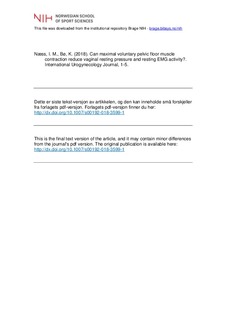| dc.contributor.author | Næss, Ingrid Margrethe | |
| dc.contributor.author | Bø, Kari | |
| dc.date.accessioned | 2019-04-04T12:49:15Z | |
| dc.date.available | 2019-04-04T12:49:15Z | |
| dc.date.created | 2018-03-15T08:33:42Z | |
| dc.date.issued | 2018 | |
| dc.identifier.citation | International Urogynecology Journal. 2018, 29, 1623-1627 | nb_NO |
| dc.identifier.issn | 0937-3462 | |
| dc.identifier.uri | http://hdl.handle.net/11250/2593353 | |
| dc.description | I Brage finner du siste tekst-versjon av artikkelen, og den kan inneholde ubetydelige forskjeller fra forlagets pdf-versjon. Forlagets pdf-versjon finner du på link.springer.com / In Brage you'll find the final text version of the article, and it may contain insignificant differences from the journal's pdf version. The definitive version is available at link.springer.com | nb_NO |
| dc.description.abstract | Introduction and hypothesis: The purpose of the present study was to assess whether attempts at a maximal voluntary pelvic floor muscle (PFM) contraction can reduce vaginal resting pressure (VRP) and surface EMG activity in women with and without provoked vestibulodynia (PVD). Method: An assessor blinded comparison study included 35 women with and 35 women without PVD. VRP and PFM strength were measured with a high precision pressure transducer connected to a vaginal balloon (Camtech AS, Sandvika Norway). PFM activity was measured before and after three MVCs with surface EMG (NeuroTrac ETS™; Verity Medical, Romsey, UK). Paired sample t test was used to analyze differences within groups and independent sample t test to analyze differences between groups. p value was set at <0.05. Results: Mean age of the participants was 24.3 years (SD 4.7) and mean BMI was 22.0 kg/m2 (SD 2.6). There were no significant differences between the groups in any background variables. PFM contraction led to a statistically significant reduction of VRP in both the PVD (p = 0.001) and the control group (p = 0.027). Surface EMG activity was significantly reduced in the PVD group only (p = 0.001). Discussion: Young, nulliparous women with PVD had significantly lower vaginal resting pressure and sEMG activity after three maximum contractions of the PFM. The results indicate that attempts at voluntary maximal contractions may be investigated as a method of reducing PFM hypertonicity. | nb_NO |
| dc.language.iso | eng | nb_NO |
| dc.subject | contraction-relaxation method | nb_NO |
| dc.subject | hypertonicity | nb_NO |
| dc.subject | muscle activity | nb_NO |
| dc.subject | pervic floor muscle | nb_NO |
| dc.subject | provoked vestibulodynia | nb_NO |
| dc.subject | vaginal resting pressure | nb_NO |
| dc.title | Can maximal voluntary pelvic floor muscle contraction reduce vaginal resting pressure and resting EMG activity? | nb_NO |
| dc.title.alternative | Can maximal voluntary pelvic floor muscle contraction reduce vaginal resting pressure and resting EMG activity? | nb_NO |
| dc.type | Journal article | nb_NO |
| dc.type | Peer reviewed | nb_NO |
| dc.description.version | acceptedVersion | nb_NO |
| dc.source.pagenumber | 1-5 | nb_NO |
| dc.source.journal | International Urogynecology Journal | nb_NO |
| dc.identifier.doi | 10.1007/s00192-018-3599-1 | |
| dc.identifier.cristin | 1572927 | |
| dc.description.localcode | Seksjon for idrettsmedisinske fag / Department of Sports Medicine | nb_NO |
| cristin.unitcode | 150,34,0,0 | |
| cristin.unitname | Seksjon for idrettsmedisinske fag | |
| cristin.ispublished | true | |
| cristin.fulltext | postprint | |
| cristin.qualitycode | 1 | |
